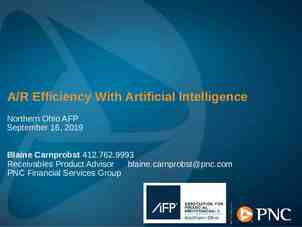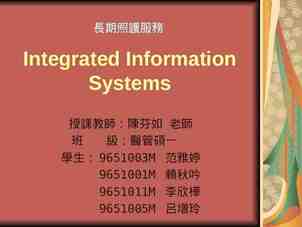GENERAL OVERVIEW OF PFAS PER- AND POLYFLUOROALKYL
31 Slides9.58 MB
GENERAL OVERVIEW OF PFAS PER- AND POLYFLUOROALKYL SUBSTANCES trcsolutions.com 25th International Petroleum Environmental Conference November 1, 2018
Today’s Topics PFAS Naming Conventions Physical/Chemical Properties of PFAS Sources of PFAS and Potentially-affected Sites AFFF Sampling Issues and Quality Control Regulatory Treatment 2
PFAS Naming Conventions 3
Quick Chemistry Lesson #1 Remember: PFAS are Per and Polyfluoroalkyl substances Per-fluoroalkyl substances: fully fluorinated alkyl tail Perfluoroalkane carboxylates (or carboxylic acids): PFCAs F (PFOA) F F F C C F F C C F F F F C F F C C F F O C COOH Head OH PFAAs F Alkyl tail, fully fluorinated Perfluoroalkane sulfonates (or sulfonic acids): F (PFOS) F F C F F C F C C F F F F C F F C F F C F C F PFSAs F SO3H SO3H Head 4
Quick Chemistry Lesson #2 Remember: PFAS are Per and Polyfluoroalkyl substances Poly-fluoroalkyl substances: non-fluorine atom (typically hydrogen or oxygen) attached to at least one carbon atom Fluorotelomer Alcohol (8:2 FTOH) F C C F F F F F C C F F F F C F F C F F F F C C F C C OH Non-fluorine atom on one or more carbons. Polyfluoroalkyl substances may also be degraded to perfluoroalkyl substances (e.g., PFOS or PFOA): PRECURSORS 5
What Are PFAS? Poly- and per-fluoroalkyl substances Generic family of chemicals Manmade and do not occur naturally Used since 1940 (Critical for the Manhattan Project) Can be branched or unbranched Short chain or long chain Used to make products that resist heat, oils, grease, stains, and water Most prevalent and researched: PFOA and PFOS trcsolutions.com 6
Chemical Properties of Perfluoroalkyl Substances C-F: Strong bond A PFAS Micelle Chemically and thermally stable Water soluble and mobile in groundwater Surfactant properties Recalcitrant in environment trcsolutions.com 7
Sources of PFAS and Potentially Affected Sites trcsolutions.com 8
Where Are PFAS Used? trcsolutions.com 9
What Types of Sites Can Be Sources of PFAS? Fire training facilities Fire stations Refineries DoD sites/Military bases Commercial and private airports Landfills (leaching from consumer products) Biosolids land application Rail yards Chemical facilities Plating facilities Textile/carpet manufacturers Residential areas with septic systems trcsolutions.com 10
Global Manufacture and Use of PFAS Prohibits Import, Manufacture, Use & Sale of PFOS/PFOA Banned Sale, Use and Import of PFOA Class B AFFF with PFAS Banned Restrict Manufacture, Import, Export, and Use of PFOS PFOA & PFOS No Longer Produced Increased Production of PFOA EtFOSA Produced on Industrial Scale PFAS Manufactured Globally trcsolutions.com 11
Aqueous Film Forming Foam (AFFF) trcsolutions.com
What is AFFF? Highly effective fire-fighting foam Used for hydrocarbon fuel fires AFFF acts as: – An aqueous foam: primary fire extinguishing agent – An aqueous film former: a fuel vapor suppressor trcsolutions.com 13
Where is AFFF Used? Airports (military/domestic) Petrochemical Facilities Municipal Fire Dept. Industrial Fixed Systems Military / Government Marine – Off Shore Fire Protection Where: – – – – trcsolutions.com Historical Use (where used to fight a fire) Fire Training Areas Nozzle Testing Areas Storage Areas 14
Types of Fluorine-Based AFFF Legacy 1 Generation AFFF PFOS based (80%) Telomer based (20%) Developed in 1960s Production ended in 2002 Inventory remains in many locations Contain or breakdown to PFOS & PFHxS and possibly PFOA Modern Fluorotelomer AFFF 2nd Generation Fluorotelomer & Precursors AFFF st Sold from 1970s - 2016 Telomers PFOR compounds (R cationic and anionic heads) “precursors” PFOR – transformation to sulfonates and carboxylates Long-chain fluorotelomers (8:2 FTS) can breakdown to PFOA Most foam mfrs transitioned to this No PFOS and no breakdown to PFOS Short-chain fluorotelomers (6:2 and 4:2 FTS) May contain trace amts of PFOA and PFOA precursors Considered lower in toxicity and reduced BAP 15
Fluorine-Free Foams Alternative to AFFF in some applications Being used at some airports and industrial facilities in Europe, Australia, and other countries Do not contain PFAS or other persistent chemicals Contain hydrocarbon surfactants, solvents, and stabilizers trcsolutions.com Fluorine-Free Foams available since early 1900s
PFAS Sampling Issues and Quality Control trcsolutions.com 17
How Do We Sample PFAS? trcsolutions.com Similar to conventional sampling (e.g., low-flow techniques, direct push, etc.) Special care required to prevent cross contamination Use of and exclusion of specific sampling equipment and materials 18
PFAS Sampling Dos and Don’ts trcsolutions.com 19
PFAS Sampling Dos and Don’ts trcsolutions.com continued 20
Other Special Considerations Field QC Decontamination of sampling equipment No pre-wrapped food or snacks Avoid cosmetics, moisturizers, hand creams on day of sampling. Do not filter aqueous samples. Visitors to site must remain at least 30 feet from sampling area. Wash hands with water after leaving vehicle before setting up on a well. Partitioning of PFAS to surface in wells and reservoirs trcsolutions.com 21
PFAS Fate and Transport trcsolutions.com
PFAS Mobility BTEX BTEX Plumes Plumes Chorinated Chorinated Ethene Plumes Plumes Ethene Other CVOC Plumes PFAS Plumes trcsolutions.com Q Theses PFAS sites are owned by DoD and are mostly Airforce bases 23
PFAS Environmental Regulations What is Occurring? – What to Expect? trcsolutions.com
PFAS: The Rapidly Changing Regulatory Landscape Follow ITRC for updates https://pfas1.itrcweb.org/fact-sheets/ State State Year Year Type Type Promulgated? Promulgated? Alaska Alaska (AK) (AK) Connecticut Connecticut (CT) (CT) Colorado Colorado (CO) (CO) Delaware Delaware (DE) (DE) 2016 2016 2016 2016 2017 2017 2016 2016 2016 2016 2016 2016 GW GW GW GW DW DW GW GW GW GW Protected Protected GW GW Non-protected GW GW Non-protected DW DW GW GW RW RW SW SW GW GW GW GW GW GW GW GW DW DW GW GW GW GW GW GW DW DW DW DW GW GW DW DW SW SW GW GW DW/GW DW/GW YY Iowa Iowa (IA) (IA) Maine Maine (ME) (ME) Michigan (MI) (MI) Michigan Minnesota Minnesota (MN) (MN) Nevada (NV) (NV) Nevada New Hampshire Hampshire (NH) (NH) New New New Jersey Jersey (NJ) (NJ) North North Carolina Carolina (NC) (NC) Oregon (OR) Oregon (OR) Texas (TX) (TX) Texas Vermont Vermont (VT) (VT) 2016 2016 2016 2016 2016 2016 2015 2015 2018 2018 2017 2017 2017 2017 2017 2017 2015 2015 2016 2016 2015 2015 2017 2017 2017 2017 2017 2017 2006 2006 2017 2017 2011 2011 2017 2017 2018 2018 YY YY YY YY YY YY P P P P YY YY YY YY YY PFOA PFOA PFOS PFOS PFNA PFNA (µg/L) (µg/L) 0.40 0.40 0.07 0.07 0.07 0.07 0.07 0.07 0.07 0.07 0.07 0.07 0.7 0.7 0.07 0.07 0.13 0.13 0.05 0.05 0.42 0.42 0.07 0.07 0.035 0.035 0.035 0.035 0.035 0.035 0.667 0.667 0.07 0.07 0.40 0.40 0.07 0.07 0.07 0.07 0.07 0.07 0.07 0.07 0.07 0.07 1 1 0.07 0.07 0.56 0.56 1.2 1.2 0.011 0.011 0.07 0.07 0.027 0.027 0.027 0.027 0.027 0.027 0.667 0.667 0.07 0.07 0.014 0.014 2 2 24 24 0.29 0.29 0.02 0.02 300 300 0.56 0.56 0.02 0.02 0.07 0.07 0.010 0.010 0.010 0.010 0.013 0.013 1 1 0.29 0.29 0.02 0.02 Other Other Gen-X Gen-X PFAS PFAS YY YY N N YY N N N N N N N N N N N N N N YY YY YY YY N N N N N N N N N N N N N N YY YY N N International: Australia Canada Denmark Germany Italy Netherlands Sweden UK 0.14 0.14 Residential soil and soil leaching standards exist also. 25
PFAS: The Rapidly Changing Regulatory Landscape Examples over the last several months Congress (Oct. 2, 2018) passed a bill to allow discontinuation of PFAS in airport fire fighting foams EPA PFAS Summit – May 2018 – Initiate steps to evaluate need for MCLs – Groundwater cleanup standards by fall of 2018 – Liability under CERCLA – PFOS/PFOA as haz. substances – Held 5 PFAS listening sessions around the country (NH, PA, CO, NC, KS) Michigan: Since the end of 2017 MI DEQ has: – Set standards for: Drinking water and Groundwater Remediation WWTP discharge standards Air emission standards – Required all POTWs to evaluate their industrial influents as PFAS sources New Hampshire has required all landfill groundwater monitoring programs to analyze for PFAS Community Action Groups expansion permit) analyzing for PFAS (e.g., A New York Landfill 26
PFAS Environmental Regulations How to Manage? trcsolutions.com
PFAS – Sampling and Analysis When, Where, What, Why and How? Know where your PFAS-use sites are and their risk. – With respect to water supplies – especially those with PFAS – Adjacent surface water bodies AFFF Inventory Change out legacy AFFF Develop SOPs for cleanup after use of AFFF Inventory of historical use, training, storage & testing sites Assess potential sensitive receptors Review state inventories 28
PFAS Remediation Alternatives - Water Fate and Transport/ Remediation Challenges Low Volatility (rules out stripping) Moderate solubility Strength of C-F Bond Treatment efficiency must be very high because of low (ppt) remediation objectives Ex-Situ Technologies Sorption/Ion Exchange – Carbon (can be effective for some PFAS, but can be inefficient) – Ion Exchange Resins (costly) Emerging technologies: trcsolutions.com – Reverse Osmosis – Membrane filtration – Thermal Treatment – SAFF – Surface Activation Foam Fractionation In Situ Technologies Emerging(?) technologies: – Carbon injection PRB or Source Area – Electro-Chemical Oxidation – ART In-Well Circulation System 29
Plug for ITRC PFAS Team Includes 350 members: industry, academia, DOD, regulatory, consulting, analytical labs and vendors Seven PFAS Fact Sheets: – AFFF Introduction – History and Use – Naming Conventions and Chemical Properties – Regulations and Guidance – Fate and Transport – Site Characterization, Sampling, Lab Methods – Remediation Technologies and Methods 2018 – Technical Guidance Document trcsolutions.com 30
Questions? Elizabeth Denly, ASQ CMQ/OE P: (978) 656-3577 E: [email protected] www.trcsolutions.com Acknowledgements: Ken Quinn, TRC Technical Director Mike Eberle, TRC Program Manager




































